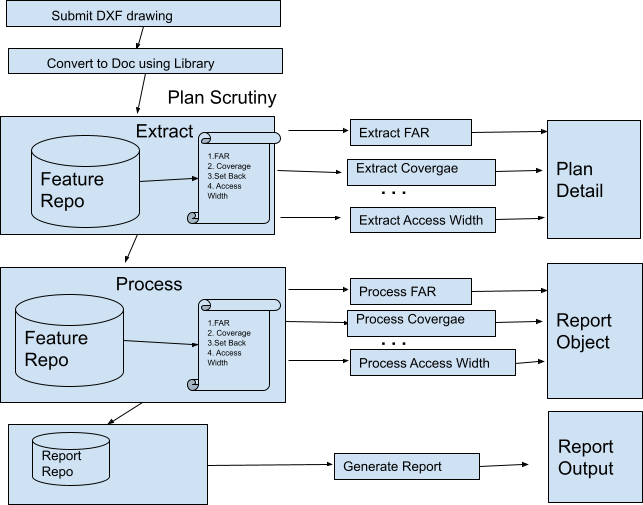Development Control Rules (Digit-DCR)
Introduction
Currently, ULBs follow a complete manual mass mode of providing various building-related approvals and related NOCs. This delays the approval process and creates a lot of inconvenience to applicants and architects. There is also a lack of transparency and accountability in this manual approach. Due to the complexity of scrutiny and approval processes and the involvement of various stakeholders, there are several challenges in the system. Some of the issues are-Complex rules and bye-laws and their interpretation, time consuming process of issuance of Planning Permission, iincreased chances of human errors due to manual submission and scrutiny, inadequate citizen interface and no single point of contact, etc.
The manual scrutiny of the building bye-laws is replaced with “Digit-DCR”.Digit-DCR is capable of reading the drawing, extract parameter values, apply it on bylaws and generate the acceptance or rejection information in seconds. This process provides a leap of 15 days cumbersome manual work to a few seconds. The Digit-DCR is even capable of marking mistakes, failing details. It converts details of drawing like Site plan, Floor plan, Elevation, etc to pdf and saves in the system.
Prerequisites
Knowledge on following
- Java
- Basics of 2D Drawing like ( Top view, Front view, Side view, etc)
- Basic Math
Functionality
High-level design
Sequence Diagram
Configuration and Set up
Support Information
References and Notes
Layer Name Standards:
General Practice of the Architects is to draw diagrams in the default layer with name “0” with portions stating Section Plan, Floor Plan, etc. With this approach, it is not possible to extract parts of the building for Bye-Laws validation. Hence Parts of the buildings should be drawn in specific layers. These layers also should have a standard format for machine-reading.
For example, Plan will have “Bathroom”, ”Washbasin” which should be validated for dimensions, counts for Sanitation. Hence these sanitation-related parts should be drawn in a layer called “BLK_1_WATER_CLOSET” layer, where “BLK_1” states it is block 1 and “WATER_CLOSET” states it is a toilet. Another example is Toilets for disabled should be validated floor wise Hence it should be defined Floorwise layer names like “BLK_1_FLR_0_SP_WC” layer.
We cannot define a complete set of layer names with these combinations because it is based on the following parameters
- Number of Blocks
- Number of Floors in each Block
- Number of Polygons on each floor
- Number of levels
So when data required at Plan Level, Block Level, Floor Level, Height it is named and prefixed accordingly
Plan Level
In the Plan level, the layer names are used without any prefix. The List of such layer names are
1 | PLOT_BOUNDARY |
2 | VERT_CLEAR_OHEL |
3 | HORIZ_CLEAR_OHEL |
4 | WASTE_DISPOSAL |
5 | PLAN_INFO |
Block Level Layer Names | |
1 | BLK_*_COVERED_AREA |
2 | BLK_*_COVERED_AREA_DEDUCT |
3 | BLK_*_BATH |
4 | BLK_*_WC |
Floor Level
Floor Level Layer Names | |
1 | BLK_*_FLR_*_BLT_UP_AREA |
2 | BLK_*_FLR_*_BLT_UP_AREA_DEDUCT |
Color Code Standards:
Some parts of the building and its validation is based on Usage(Occupancy) types. For example, every floor which all types of usage present have to be defined. Based on usage type parking has to be calculated. So only layer name is not sufficient to differentiate but color also to include. Hence Floorwise built-up area will be defined in “BLK_1_FLR_0_BLT_UP_AREA” with index color 2 for Residential type of usage. All colors are defined based on Occupancy type. Below list provides the color codes for each occupancy-
1 | Residential | 1 | |
| 2 | Commercial | 8 | |
| 3 | Apartment/Group Housing | 2 | |
| 4 | Hostel/ Residential building Lodging purpose/Guesthouse | 19 |
Drawing Standards :
The following components are used in the drawing. EDCR deals with an only defined set of drawing components.
Drawing Components | |||
Serial No | Type | Supported | Required |
1 | Line | YES | YES |
2 | Dimension | YES | YES |
3 | PolyLine | YES | YES |
4 | Circle | YES | YES |
5 | Arc | NO | NO |
The Drawing Layers used in the Digit-Dcr are

